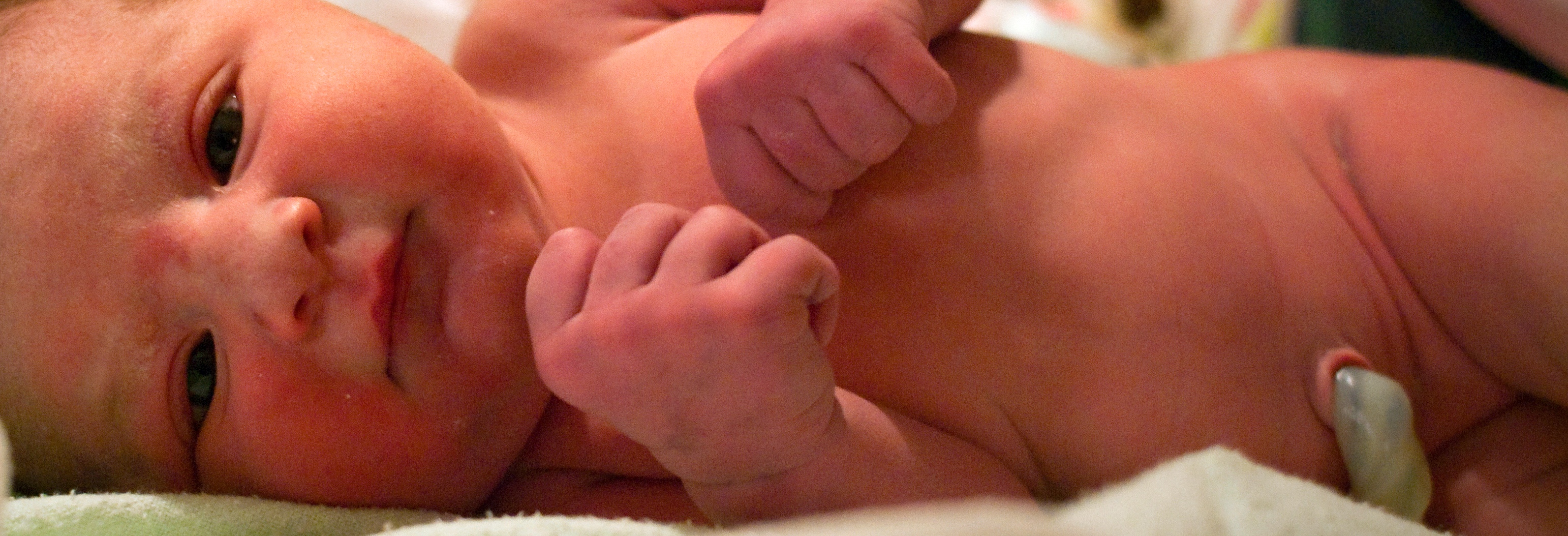
Lately some of the women with whom I work, have been advised by their doctor that their babies umbilical cord should be cut immediately after birth to prevent jaundice. While I respect these doctors, in this particular case I do not believe that they are practicing evidence based care.
What’s evidence based care?
Evidence-based practice means using quality scientific information for making a judgment. By identifying well-conducted research and applying it to practice, health care providers can improve the quality of care to mothers and babies. Something that everyone involved wishes for!
There is a large amount of scientific research showing the benefits of baby receiving the cord blood.
* The blood in the placenta rightfully belongs to the baby, and babies not receiving this blood have the deal with the equivalent of a major blood loss or hemorrhage at birth. It is estimated that early clamping deprives the baby of 54 to 160 ml of blood, which represents up to half of a baby’s total blood volume at birth.(5)
* There is a significant amount of iron in the cord blood which the baby needs for optimal health and for the prevention of anemia. (1, & numerous other clinical studies)
*Babies benefit from the increased oxygen available to them from the cord-blood when the taking these first few breathes. The earlier the cord is clamped, the more likely the incidents of respiratory distress syndrome.(3)
* The blood that babies receives through the cord after birth acts as a source of nourishment that protects infants against the breakdown of body protein. (2)
*As an added bonus, delayed cord clamping keeps babies in their mother’s arms, the ideal place to regulate their temperature and initiate bonding and breastfeeding.
The only concern with delayed cord-clamping is a possible increase in hyperbilirubinemia, more commonly known as jaundice. To fully understand this situation one must understand that there are two situations where jaundice is present… normally occurring jaundice which happens in a natural birth without any inventions known as physiological jaundice. Jaundice in this circumstance will resolve itself without the need for treatment. Non physiological jaundice arises when medical interventions, medications crossing into the placenta and premature birth occur. This type of non physiological jaundice requires special consideration and neonatal help, but is very treatable. Treatment involves exposure to sunlight & phototherapy.
Below I have included a research study which summarized the available research. It was published in 2007 in the Journal of the American Medical Association. It is important to note that there has been a large of amount of research done of this topic and the studies consistently note that the significant benefits outweigh the possible detriment of allowing the cord to finish pulsing before it is cut. I urge everyone to do their own research on this important issue, so that you can decide what’s best for the wellbeing of your child.
Late vs Early Clamping of the Umbilical Cord in Full-term Neonates
Systematic Review and Meta-analysis of Controlled Trials
Eileen K. Hutton, PhD; Eman S. Hassan, MBBCh
JAMA. 2007;297:1241-1252.
Context With few exceptions, the umbilical cord of every newborn is clamped and cut at birth, yet the optimal timing for this intervention remains controversial.
Objective To compare the potential benefits and harms of late vs early cord clamping in term infants.
Data Sources Search of 6 electronic databases (on November 15, 2006, starting from the beginning of each): the Cochrane Pregnancy and Childbirth Group trials register, the Cochrane Neonatal Group trials register, the Cochrane library, MEDLINE, EMBASE, and CINHAL; hand search of secondary references in relevant studies; and contact of investigators about relevant published research.
Study Selection Controlled trials comparing late vs early cord clamping following birth in infants born at 37 or more weeks’ gestation.
Data Extraction Two reviewers independently assessed eligibility and quality of trials and extracted data for outcomes of interest: infant hematologic status; iron status; and risk of adverse events such as jaundice, polycythemia, and respiratory distress.
Data Synthesis The meta-analysis included 15 controlled trials (1912 newborns). Late cord clamping was delayed for at least 2 minutes (n = 1001 newborns), while early clamping in most trials (n = 911 newborns) was performed immediately after birth. Benefits over ages 2 to 6 months associated with late cord clamping include improved hematologic status measured as hematocrit (weighted mean difference [WMD], 3.70%; 95% confidence interval [CI], 2.00%-5.40%); iron status as measured by ferritin concentration (WMD, 17.89; 95% CI, 16.58-19.21) and stored iron (WMD, 19.90; 95% CI, 7.67-32.13); and a clinically important reduction in the risk of anemia (relative risk (RR), 0.53; 95% CI, 0.40-0.70). Neonates with late clamping were at increased risk of experiencing asymptomatic polycythemia (7 studies [403 neonates]: RR, 3.82; 95% CI, 1.11-13.21; 2 high-quality studies only [281 infants]: RR, 3.91; 95% CI, 1.00-15.36).
Conclusions Delaying clamping of the umbilical cord in full-term neonates for a minimum of 2 minutes following birth is beneficial to the newborn, extending into infancy. Although there was an increase in polycythemia among infants in whom cord clamping was delayed, this condition appeared to be benign.
Author Affiliations: Department of Obstetrics and Gynecology, McMaster University, Hamilton, Ontario (Dr Hutton); and The Child and Family Research Institute (Dr Hutton), Western Regional Training Centre for Health Services Research (Dr Hassan), and Department of Health Care and Epidemiology (Dr Hassan), University of British Columbia, Vancouver
********************************************************************
If you wish to understand this issue on the deeper level, I recommend reading the following 2 articles.
One by an OBGYN who blogged about this topic. This article is particularly good to print out and give to your doctor.
http://academicobgyn.com/2009/12/03/delayed-cord-clamping-should-be-standard-practice-in-obstetrics/
The second is by Dr. Sarah Buckley. I have included the beginning of the article, but follow the link to read it in its entirety.
Leaving well alone: A natural approach to the third stage of labour
© Dr Sarah J Buckley 2005 www.sarahjbuckley.com
This paper was first published in Lotus Birth Shivam Rachana, Greenwood Press, Melbourne Australia 2000.
A new expanded version of this article, which updates all information and adds information about cord blood banking, cord clamping with caesarean birth and a list of recommendations for a gentle third stage, is published in Sarah’s Gentle Birth, Gentle Mothering: The wisdom and science of gentle choices in pregnancy, birth, and parenting.
The medical approach to pregnancy and birth has become so ingrained in our culture, that we have forgotten the way of birth of our ancestors: a way that has ensured our survival as a species for millennia. In the rush to supposedly protect mothers and babies from misfortune and death, modern western obstetrics has neglected to pay its dues to the Goddess, to Mother Nature, whose complex and elegant systems of birth are interfered with on every level by this new approach, even as we admit our inability to understand or control these elemental forces.
Medical interference in pregnancy, labour and birth is well documented, and the negative sequellae are well researched. However, medical management of the third stage of labour- the time between the baby’s birth, and the emergence of the placenta-, is, to my mind, more insidious. At the time when Mother Nature prescribes awe and ecstasy, we have injections, examinations, and clamping and pulling on the cord. Instead of body heat and skin-to-skin contact, we have separation and wrapping. Where time should stand still for those eternal moments of first contact, as mother and baby fall deeply in love, we have haste to deliver the placenta and clean up for the next ‘case’.
Medical management of the third stage, which has been taken even further in the last decade, with the popularity of ‘active management of the third stage’ (see below), which has its own risks for mother and baby. While much of the activity is designed to reduce the risk of maternal bleeding, or postpartum haemorrhage (PPH), which can be a serious event, it seems that, as with the active management of labour, the medical approach to labour and birth may actually lead to many of the problems that active management is designed to address.
http://www.sarahjbuckley.com/articles/leaving-well-alone.htm
1. Ceriani Cernadas JM, Carroli G, Pellegrini L, Otaño L, Ferreira M, Ricci C, Casas O, Giordano D, Lardizábal J. The effect of timing of cord clamping on neonatal venous hematocrit values and clinical outcome at term: a randomized, controlled trial. Pediatrics. 2006 Apr;117(4):e779-86. Epub 2006 Mar 27.
2. De Marsh, Q. B., et al. “The Effect of Depriving the Infant of its Placental Blood.” J.A.M.A. (7 June 1941).
3. Saigat, Saroj, et al. “Placental Transfusion and Hyperbilirubinemia in the Premature.” Eds. 49:3 (March 1972).
4. Rabe, H; Reynolds, G; Diaz-Rossello, J. Early versus delayed umbilical cord clamping in preterm infants (Cochrane Review). Chichester (United Kingdom): John Wiley and Sons; 2006.
5. Usher R, et al. “The Blood Volume of the Newborn Infant and Placental Transfusion”. Acta Paediatr 1963;52:497-512.
A recent news article which shows that the mainstream medical community is increasing leaning towards delayed cord clamping in newborns. http://uk.health.lifestyle.yahoo.net/expert-calls-for-delayed-clamping-of-umbilical-cord-in-UK-childbirths.htm
And finally a great ted talk on this subject.
http://tedxtalks.ted.com/video/Alan-Greene-at-TEDxBrussels;Featured-Talks
If you enjoyed this post, you might also like these two articles as well.
The white stuff you see on baby’s back and head is vernix. The thicker it is the more you can see it. Here are several abstracts on the antibacterial properties of vernix. There’s a good reason why babies should not be bathed right away after birth.
The power of vernix is truly astounding. Its main benefits are its various antimicrobial properties, which help protect a newborn against a wide variety of infections. A secondary benefit is that vernix is highly moisturizing. To such a degree that many cosmetic companies have researched it. Keep Reading
Here is the curious answer. QUITE POSSIBLY. You simply can’t assume safety testing on any personal care products. Why is that?
Well currently, Health Canada does not require any company to prove that their product is safe by any independent testing before it hits the market. Researchers have to proof something is unsafe before it gets pulled off the shelves. That’s why bisphenol A was common in baby bottles for years until enough research showed that it is harmful. The makers of bisphenal A never needed to prove that it was safe before they added to products. Doesn’t that seem backwards to you? It sure does to me. Keep Reading.







6 thoughts on “Late vs Early Clamping of the Umbilical Cord in Newborn Babies”
A great article Marie – thanks for sharing! A few days before I delivered, I too became curious about the literature on early cord clamping. I was amazed at the number of studies and theories suggesting that this practice leads to a variety of health problems and longterm health issues in children. For some conditions, like autism, the jury is still out and there isn’t enough evidence to know for sure – but I quickly realized how important of a decision this could be for my baby! (Up until that point I had included it on my birthing preferences letter under the advice of the Hypnobirthing program, but didn’t know much about the rationale behind it!)
The OBGYN-resident respected my wish to delay clamping until the cord stopped pulsating (or she said it had anyway)- which was only about 1-2 minutes after my baby was delivered. Because my husband and I had chosen to do cordblood banking, I was concerned that there wouldn’t be enough blood to fill the vials. (However, I reasoned that it was more important for my baby to get these vital stemcells at the time of his birth, something that likely will benefit him now and throughout his life). It turned out that there was enough blood for the cordbanking, even after delaying clamping. I was happy about this, but the Buckley article seems to suggest that if you delay clamping then there won’t be enough cordblood to bank? I did read an article by a labour and delivery nurse who said that she always finds there is enough blood for banking after delayed clamping – she said that sometimes you just need to “milk the placenta” after it is delivered.
Hi Brandy,
Thanks for the info. I haven’t had anyone here do both the cord banking and the delayed cord clamping, but the information that I had from other hypnobirthing practitioners, is that it is possible to do both. I’m glad to hear that someone close to home did both as well. I would agree with your delivery nurse. 🙂
Thanks Marie for the info on this important topic, and for including my article. My new book has an update of this with alot more information about the pros and cons of cord blood banking.
Below is my take on delayed clamping and cord blood banking, from my book,
I would urge families to read the whole chapter before deciding on this issue, which medical research (and most profesoional bodies) shows is very very very unlikely to be useful to the baby or family.
More about my book here
http://www.sarahjbuckley.com/html/new-gentle-birth-gentle-mothering.htm
Blessings, Sarah
Although cord blood harvesting is promoted by both public and private
institutions as harmless to the baby, it involves collecting the newborn’s
placental transfusion and requires early clamping—ideally within thirty
seconds of birth—so that an adequate number of stem cells is obtained.
Delayed cord clamping, which allows this blood to transfer to the baby,
as discussed earlier, is likely to lead to an inadequate volume of blood
harvested.
For example, in one study the volume of cord blood obtained was
reduced from 75 milliliters, collected when the cord was clamped at 30
seconds after birth, to 39 milliliters collected when clamping occurred
between 30 and 180 seconds. A low-volume collection indicates insufficient
stem cells to be usable for transfusion.(ref 103) Public cord blood banks generally discard collections below 40 milliliters [because of an inadequate number of stem cells for later use],(ref 104) with overall one-third to onehalf
of collections discarded, mostly because of low volume.96, (ref 105) Private
banks, which are paid by parents to collect and store their baby’s blood, do
not generally discard the collections, and some may have a policy to accept
lower volumes, although this may not guarantee usefulness.
Some centers collect residual blood from the placenta after it is delivered,
although the amount is usually less than that obtained from the
cord straight after birth, and still requires early cord clamping for an
adequate collection.(ref 103) Contamination is also more likely with a placental
collection.
: